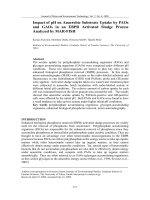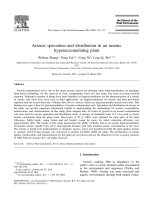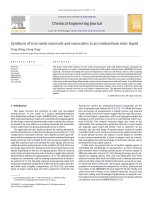Precarious labour and informal economy work, anarchy, and society in an indian village
Bạn đang xem bản rút gọn của tài liệu. Xem và tải ngay bản đầy đủ của tài liệu tại đây (2.77 MB, 270 trang )
Smita Yadav
Precarious Labour and
Informal Economy
Work, Anarchy, and Society
in an Indian Village
Precarious Labour and Informal Economy
Smita Yadav
Precarious Labour
and Informal
Economy
Work, Anarchy, and Society in an Indian Village
Smita Yadav
University of Brighton
Brighton, UK
and
University of Sussex
Brighton, UK
ISBN 978-3-319-77970-6
ISBN 978-3-319-77971-3 (eBook)
/>Library of Congress Control Number: 2018936603
© The Editor(s) (if applicable) and The Author(s) 2018
This work is subject to copyright. All rights are solely and exclusively licensed by the
Publisher, whether the whole or part of the material is concerned, specifically the rights
of translation, reprinting, reuse of illustrations, recitation, broadcasting, reproduction
on microfilms or in any other physical way, and transmission or information storage and
retrieval, electronic adaptation, computer software, or by similar or dissimilar methodology
now known or hereafter developed.
The use of general descriptive names, registered names, trademarks, service marks, etc. in this
publication does not imply, even in the absence of a specific statement, that such names are
exempt from the relevant protective laws and regulations and therefore free for general use.
The publisher, the authors and the editors are safe to assume that the advice and
information in this book are believed to be true and accurate at the date of publication.
Neither the publisher nor the authors or the editors give a warranty, express or implied,
with respect to the material contained herein or for any errors or omissions that may have
been made. The publisher remains neutral with regard to jurisdictional claims in published
maps and institutional affiliations.
Cover image: © Christina Sarmiento/EyeEm
Printed on acid-free paper
This Palgrave Macmillan imprint is published by the registered company Springer
International Publishing AG part of Springer Nature
The registered company address is: Gewerbestrasse 11, 6330 Cham, Switzerland
To Zen and Alex
Foreword: If Not the State Then Who?
Post-Weberian definitions of a state, and its competences, have gradually
added a variety of tasks that a state is expected to perform to be legitimised amongst its citizens. Indeed, nowadays the state is not only the
only entity with the monopoly on the use of force, it is also an education
provider, helps reallocating welfare and labour force, supports vulnerable
citizens and groups, collects taxes to redistribute revenues and, in some
extreme cases, protects citizens from their own (unhealthy) wishes—for
instance, with higher taxes on alcohol or cigarettes.
What if a state fails to fulfil one or more of the above roles? One could
easily think that the state is not functioning properly to the point that it
might be considered a “failed state.” But, what if the state were not the
response to everything? Twentieth-century history has been an escalation
of the importance of a state in citizen’s life. Rousseau’s social contract
has complicated to include more obligations from both sides, at least in
theory. Interestingly enough, this has also come with a gradual liberation
of the state from (some) economic obligations. The neoliberal paradigm
that has gradually gained consensus has put emphasis on the role of the
state as indirect regulator but overemphasised the role of other non-state
economic actors.
This apparently overwhelming consensus on the roles and limits of
the state has come under question, fortunately, by what can be regarded
as the manifesto for alternative economies. Since its appearance, “The
end of capitalism as we know it” (by Gibson-Graham) has been used
vii
viii
Foreword: If Not the State Then Who?
in a variety of settings, and contexts, to challenge the taken-for-granted
omnipresence of the state in virtually all aspects of its citizens’ life.
However, not only a state can underperform, fail to deliver what it
is expected to deliver, refuse to take care of some aspects of its people’s
life and this can be due to a series of limitations in the conception of the
state or capitalism as it has been designed. Even more important, people,
as individuals or as a society, have agency. They have the agency to limit
the state, reject its interventions or renegotiate its role in one or more
aspects of their life. This happens not only if they want to engage with
criminal activities. It can also be the result of political measures that are
in contrast with what a percentage of the citizens of a state cannot live
with. This could also come from a desire to propose alternative models
of governance that are more consistent with a local culture, a context, or
that have a more human face, allowing people to live the life they want
and not the one that their state imagine. This is, at least, one of the lessons one can draw from seminal works by scholars like James C. Scott or
Joel S. Migdal.
What we can see in practice are tendencies, practices or even informal
institutions that have come to contrast the neoliberal model by putting
the accent on more social aspects of the economy. This could be seen as
starting from the very idea behind the concept of sustainable development, for which growth should happen keeping into account also social
and ecological factors. However, this vision has evolved in a variety of
directions emphasising the social aspect of the economy, the fact that
growth is not the response to everything or the paradigm we should all
ascribe to, hence the term—amongst others—degrowth.
Smita Yadav’s Ph.D. thesis, and the subsequent book here, nicely
locates in the above debates. In her detailed account of how a community lives, and survive, precariousness induced by a state that is partly
absent, she documents the capacity, by individuals, households and eventually an entire village that is able to survive “beyond” or “in spite of ”
a state. She unveils a conflictual and contradictory logic according to
which a state and its institutions are needed and not needed at the same
time. A state is needed, as a general assumption of the twenty-first century, and indeed it can have a role in any community’s life. However, the
presence of a state as an overarching entity is not sufficient to regulate
citizen–citizen, or to manage citizen–institution, relations. A state should
not just be a state nominally but in fact also act as a state, being this a
distinction that is not always made.
Foreword: If Not the State Then Who?
ix
In this respect, Smita’s deep, and thick, descriptions of intra-village
dynamics, power relationship and the way people live this precariousness do not only ascribe to the larger stream of diverse economies. It
also demonstrates that a state is not always needed and people, once
they realise its absence, can manage to live without it thus looking for
a dialogue. This is, however, not just one way of interpreting her rich
empirical material and the analysis she offers. It is also a way to look at
her work as valid well beyond the context she works in. This is a book
on India but not only. It is likewise an anatomy of how substate units
work without a state or, with limited support from it. Do these people still need a state thus? They probably need but what they also need
is a dialogue with a state that is willing to listen to their feedback and
take measures to meet their needs. If elections and referenda are a way
to gather formal feedback, to express a perceived need, measurement
and understanding of informality can be used to gather informal feedback and understand unexpressed, or veiled, needs. Informality needs
to be understood and become an instrument informing governance
mechanisms, rather than being considered an element undermining the
(alleged) effectiveness of a given system.
Dr. Abel Polese
Senior Research Fellow (Vanemteadur)
Tallinn University, RASI
Tallinn, Estonia
E-mail:
Academia.edu profile: />
Preface
an adivasi (Indigenous) means to labour but different than a wage
labourer
Humans have always strived for freedom and autonomy and have
learnt very early on that for this experience, they will have to labour. They
choose to experience this through either formal or informal, d
epending
upon their subjective interpretations of the terms, contingencies and conditions that can satisfy the values they seek for themselves and for their
families. The story of the Gonds, in their own voices, is covered throughout this book and highlights all the empirical conditions in which the
Gonds have successfully experienced this autonomy through precarious
forms of work. Even though their rights to forests have been suspended
and they are not able to practice autonomy against the autocratic forest
department, they are experiencing autonomy in the informal economy.
They choose their own wage work, fix their own wages, choose the
site of the work and can leave and begin work as and when they desire.
Migration is also an example of such an anarchic form of resistance
towards the constrained choices due to forest restrictions. The income
stream from migration is purely used to maintain status quo within
their community even though access to local money lenders is still an
option, for example, to afford expense of dowry and marriages which has
recently become a major source consumption amongst the Gonds. Thus,
through migration and other sources of income combined, Gonds maintain autonomy and stay debt free.
xi
xii
Preface
Even if they are unable to read and write, the virtues of labouring
have allowed the Gonds to quickly assess their niche in the labour market to do precarious forms of work in the region for cash which is supplemental to their subsistence-based agriculture. At the same time, the
institutions of household—family, kinship, division of labour between
the sexes, marriages, reciprocity, relations of labour and land exchange,
gifts, and mode of production—become the central focus of tribal life as
described in this book.
Current scholarship on studying Indian economic growth is divided
over how to interpret the growing informality and unorganised nature
of its economy. Marxist scholars remain firm that it is exploitative and
unfavourably against the labourers. They refer to such jobs as being
precarious due to their nature of contract being temporary, irregular,
insecured or seasonal. The other concern by current Marxist scholars
studying poverty and labour studies of the Indian economy suggest that
there is no formal union along the lines of the trade unions as in the
west. Consequently, this should make the workers in India vulnerable
against undignified wages and working in conditions.
Social development scholars doubt the ability of informal economy
to reach social transformation and social change equally for everyone if
India’s economic growth continues to remain unregulated. Both view
the informality as a perverse mechanism by privileged groups of people
to hide low wages of the labourers who are also made to work longer
hours, in unhygienic working conditions with no security and protection
at the work site. They demand for a more transparent and accountable
system to replace informality.
The conclusions from these studies are clear: only formal and salaried jobs can ensure dignity, security and lead to a viable form of living.
However, this does not account and leaves too many poor in countries
like India that rely majorly on informal work and can also experience dignity through independent means of livelihood. The social and Marxist
portrayal of poor being in perpetual debt and stuck doing precarious
forms of work needs re-examination in the face of the burden of so many
people making a living through insecured and irregular forms of informal
and precarious work. The book offers an alternative to explaining surplus
labour production in the context of poverty out of displacement due to
forest policies. In such a context, all rights are suspended and the forest
rule has become widespread as a result of two sets of forces: a new round
of enclosures that have dispossessed large numbers of rural people from
Preface
xiii
the land and the low absorption of their labour, which is “surplus” to the
requirements of primitive forms of capital accumulation—land grab by
displacing the poor in the name of forest conservation.
The book also makes a case to re-examine previously held view about
labourer’s weak bargaining cannot be overlooked. The choices that
Gonds have made challenge anthropology of freedom, community, individual and agency and show we still need more rigorous understanding of how and why people can freely choose to labour, negotiate their
wages and the terms of their working conditions even if they do not
have access to the formal state. Do these virtues have any value and is it
even possible to have such virtues which are limitless autonomy through
labour in our present capitalist society?
Ironically, institutions of kinship and patriarchy were viewed as constricting freedoms and anarchy of the individual and so formal and
organised institutions were preferred for the labourer. However, such
formalised unions and associations abstract the labour and make the
affiliation to the group as the primary aim. This might certainly work in
capitalists and social welfare contexts where work, even if limited, is guaranteed with limited autonomy and freedom as being part of the group
takes over than the benefits and the return of the work itself. Thus, being
part of the union through race, class and gender quotas has to be introduced for diversity. But this formalised union and organisations might
not work in contexts where having work—formal work—is not even an
option like for the Gonds. The only option is to remain invisible, unorganised, autonomous, anonymous and stateless until such reliable, formalised and regular but limited sources of income become available.
It shows us the limits of the institution of state and brings in the institution of labour and capital as superstructures that the state cannot regulate. At no time during the fieldwork were the Gonds convinced about
the idea of the state and they gave all the evidence of it throughout the
fieldwork.
The book tells the story of statelessness, dignity, welfare and autonomy through the voices of one such community—the Gonds. My focus
in this book is to offer another alternative to explaining surplus labour
production in the context of poverty out of displacement due to forest
policies. In such a context, all rights are suspended and the forest rule
has become widespread as a result of two sets of forces: a new round of
enclosures that have dispossessed large numbers of rural people from the
xiv
Preface
land and the low absorption of their labour, which is “surplus” to the
requirements of primitive forms of capital accumulation—land grab by
displacing the poor.
Brighton, UK
Smita Yadav
Acknowledgements
This work would not have been possible without the moral support of Zen,
a polymath, whom I know since my Mumbai days while studying physics
and who continues to influence me intellectually and philosophically.
I am immensely grateful to the people of Panna who at various points
hosted me found my fieldwork and advised me to be safe while I was still
adjusting to a new climatic and cultural conditions and show patience
while I took time to adjust to the rhythms of village life. I am indebted
to the Gonds with whom I have built lifelong relations and who have
inspired me to appreciate the causes of the migrant workers’ rights and
to accept me into their lives and to understand the meanings of dignified
and decent wages which have now become my own future research interests and inspiring me to explore the relation between work and anarchy.
I am thankful to my supervisors, Katy Gardner and Geert de Neve,
at Sussex, my dissertation examiners Janet Seeley and Maya Unnithan,
and other faculty members who helped shape the outcome of the book
with their patient reading of my drafts of the original thesis which was
submitted in 2016. I am grateful to all of those with whom I have had
the pleasure to work during the writing. I am also grateful to Andrea
Cornwall of Sussex Global Studies to make sure I had the right resource
support while I completed the book. Nobody has been more important
to me in the pursuit of this project than Alex whose infinite patience is
with me in whatever I pursue. Also, to my mother who despite not being
part of the formal academic world has finally come to accept and appreciate my academic and career choices since this project started in 2012.
xv
xvi
Acknowledgements
Special thanks to Marloes Janse of SOAS, London; and Raminder
Kaur at the University of Sussex for initially planting the idea of a mono
graph in my head. The various chapters were presented at conferences
and workshops such as the Development Studies Association, Association
of Social Anthropologists, Mobility Workshop in Freiburg, University
of Madras and King’s India Institute at King’s College in London. I
am also grateful to the Royal Anthropological Institute for funding
the Ph.D. dissertation fieldwork. I am also grateful to Kuntala LahiriDutt from the Australian National University who first introduced me
to the mining villages in the district of Panna. This book has benefited
immensely from the careful reading of Janet Seeley and Maya Unnithan
who served as my examiners and helped to refine my initial thesis. Also,
I want to thank Michael Myburgh and others for offering to edit various
portions of the book. A special thanks to the commissioning editor of
Springer Publishing to be very patient and to allow me to take my time
to complete the manuscript.
Contents
1 Introduction: Urgent Anthropology1
1.1Introduction
1
1.2 Plan of the Book: Politics of Labour, Methodology
and Urgent Anthropology
3
1.3 Earlier Documentation of Gonds in Panna
10
1.4 Forest Rights
14
1.5 Feelings of Frustration, Discontentment and Politics
of Livelihoods
18
1.6 The National Park
22
1.7 The Gonds Curiosity About the Buffer Zone
24
1.8 Conflict Over the Understanding of Forest
Management
26
1.9 Democracy and Politics of Withdrawal from
Welfare State
29
1.10 Field Immersion: Settling Down and Village Selection 32
1.11Conclusion
39
References
41
2 Local History and the Postcolonial State:
The Invisibility of Gonds43
2.1Introduction
43
2.2 The District of Panna
44
2.3 Bundelkhand and Panna
47
2.4 Webs of Tradition and Modernity in Panna
49
xvii
xviii
Contents
2.5
2.6
Caste and Ethnic Lines of Occupation
The Gonds in Panna District
2.6.1 The Fall of the Gonds and the Rise
of the Rajputs in Bundelkhand
2.7 Collective Memory and Oral History
of the Past Before the State
2.8 Pauperisation, Slow Change and Gradual Invisibility
of the Gonds
2.9 The Social Hierarchy Amongst the Gonds
and with Other Communities
2.10 Gonds and Mining
2.11 The Stone Quarry Lease
2.12 Political Economy of Stone Quarry
2.13 Gond’s Experience on Starting a Stone Quarry
2.14 The Village Layout/House Structure
2.15Conclusion
References
3 Basic
3.1
3.2
3.3
51
55
58
59
67
69
71
74
76
77
79
80
81
Income, Forests and Anarchy83
Introduction: Anarchic Anecdotes
83
Labouring Lives
85
Gonds as Subsistence Farmers-Patriarchy
and Kinship Norms
89
3.4 Landholdings, Ownership and Land Grabbing
91
3.4.1 Types of Farming
92
3.5 Stone Quarries
94
3.6 Working on a Piece-Rate Basis in Stone
Mines/Contractual Work
96
3.7 The Labour Contractor
98
3.8 Death by TB
98
3.9 NMDC and Its Relation with the Villages
in the Tiger Reserve
99
3.10 The Case of India’s Universal Basic Income
101
3.11Alcoholism
102
3.12 Spirit Possession, Shamans, and Indigenous Healing
103
3.13Conclusion
104
References
105
Contents
xix
4 Family and Kinship: The False Binary of the Subjective
and Empirical Definition of a Household107
4.1 Lineage and Family Systems of the Gonds
107
4.2 Nyaarpanna (Separation of the Cooking Hearth)
108
4.3 The Dichotomies of “Household” and “Family”
110
4.4Marriage
113
4.4.1 Stages of Marriage
114
4.4.2 Sharing the costs of the Wedding Ceremony
115
4.5 Types of Gond Women in Mahalapur
117
4.5.1 Women Married into Mahalapur
117
4.5.2 Uxorilocal Women
120
4.5.3Widows
121
4.6 Inter-generational Participation of Work
in a Gond Household
124
4.7 Child Work Participation
124
4.8Conclusion
129
References
129
5 Narratives of Kamayee/Dhanda (Income):
Modes of Wages131
5.1Introduction
131
5.2 Brief Review of Diversification Livelihood Framework
and Social Capital
133
5.2.1 Livelihood Diversification, Vulnerability
and Strategies
133
5.2.2 Social Capital, Social Networks
and Social Protection
138
5.3 Brief Description of Different Sources of Dhanda.
Sources of Income/Wage/Trade
142
5.3.1 Forest-Related Activities
142
5.3.2Migration
144
5.3.3 Road Construction
144
5.4 Case Studies
145
5.4.1 Leela Bai
145
5.4.2 Nandlal Adivasi
147
5.4.3 Multiple Earners and “Older Female Earners” 148
5.4.4 Emergency and Unforeseen Hardships
150
5.4.5 Change in Household Development Cycle
152
xx
Contents
5.5
Inter-generational Change in Livelihoods
5.5.1Ramcharan
5.5.2Nandu
5.5.3 Gharjamayees
5.5.4 Gond Women, Work Participation
and Hinduisation
5.6Conclusion
References
153
154
154
155
156
159
160
6 State (Sarkar) and Society (Samaj)165
6.1Introduction
165
6.2 Land vs. Social Benefits
168
6.3 Politics of the Cards
170
6.4 Labelling and Accessing Social Benefits
172
6.5 Understanding the Government Programmes
in Mahalapur
173
6.5.1 Housing in Mahalapur
175
6.5.2 Schooling of Gond Children
176
6.5.3 The Rural Employment Guarantee Programme 186
6.6 Hi-Tech Rural India and Its Paradoxes
192
6.7Conclusion
193
References
196
7Conclusion199
References
219
Glossary225
Bibliography229
Index251
About
the
Author
Smita Yadav is an anthropologist interested in power, statelessness/state,
anarchy, postcolonial theory, labour, gender, religion, secularism, indigenous knowledge, environment, theory and politics of ethnography, and
politics of development and welfare. She has over ten years experience
working as a consultant and academic on these topics in India, US, and
UK. She is currently preparing a project on religion, secularism, state,
and development in India. She is a visiting lecturer in Human Geography
at the University of Brighton and is a Postdoctoral research associate at
the University of Sussex where she completed her PhD in Anthropology
in 2016. The fieldwork on the Gonds in India was conducted from May
2011–May 2012.
xxi
Abbreviations
BPL
GoI
NMDC
NREGA
UBI
Below Poverty Line card
Government of India
National Mineral Diamond Corporation
National Rural Employment Guarantee card
Universal Basic Income
xxiii
Map of India
Map of MP State
CHAPTER 1
Introduction: Urgent Anthropology
1.1 Introduction
“We are not poor. Poor means unable to afford food, clothing, and
shelter. We have all that, but we are Majboor (vulnerable),” says Aditya,
a Sur Gond in the village of Mahalapur, cautioning me not to judge
him and his village by their constrained choices of doing precarious
forms of work. Aditya is young and unemployed. Despite being a graduate with qualifications and hoping to get a teaching job in his village
school, he does casual, unskilled wage work in the stone quarries nearby
in order to make a decent wage. The Gonds (who are spread all over
the country and speak different regional dialects) have historically been
a predominantly forest-based community. However, in 1994 the Panna
Tiger Reserve restricted their access to the forests by imposing sanctions, including fines and imprisonment. Today, such villages with predominantly tribal populations are being rooted out of their forests to
build dams or for wildlife conservation projects, reducing them to wage
labourers. But the Gonds seek to be autonomous, control their own welfare and meet their needs by diversifying their livelihoods even as they
battle the state against displacement and resettlement from the forests.
Some households engage in multiple occupations, while others survive
on a single source of income. Seasonal migration is taken up to work in
construction and stone quarries both in-state and out-of-state of Madhya
Pradesh. Mahalapur is one amongst many grams in India that have been
reduced to labour colony for the wider “development” of the region.
© The Author(s) 2018
S. Yadav, Precarious Labour and Informal Economy,
/>
1
2
S. YADAV
More than half of the older generation in Mahalapur has perished to
silicosis because it was incorrectly diagnosed as tuberculosis. Improper
diagnosis and treatment of silicosis often led to premature death, typically around the age of 40 (Baviskar 2008). The 27 out of the 71
households that I covered in surveys (table in Chapter 2) are widowed
households. The technology, from Switzerland, to detect and diagnose
the disease arrived only in 2011 when I started my fieldwork. The stonequarry workers are being X-rayed for their free medical treatment by the
government. Gond children from a young age are found helping family
members earn a living in the region. The closure of stone quarries, a crucial source of income for everyone in the region including the Gonds,
inside the forest and growing restrictions on forest access affect everyone
in the district of Panna. These changes, however, raise particular challenges for Gond households, especially for widowed households who
faced greater constraints as they are completely forest depended unlike
other marginalised communities. Schooling is the only time children can
take a break from various household chores such as preparing dinner or
storing water as there is no running water in most houses and modern
amenities to keep the cost of living low through woods used for heating
and cooking.
Precarious lives coupled with illiteracy make the Gonds unable to
articulate their needs and choose to labour and migrate to cities and
escape bondage and starvation. Their relations with the forests and state
are growing more weaker by the day. Most see integration with the wider
Hindu community as the best way forward at the moment. This book
therefore makes a strong case for urgent anthropology before the Gonds
completely integrate and loose their unique cultural heritage and identity.
The Gonds are à Schedule Tribe (ST) community in the Panna district
of Madhya Pradesh. The book aims to document how changing political
economy in the region, such as the closure of quarries and restrictions
on forest access, has led Gonds to engage in a wide range of livelihood
activities. Gond migration within the state of Madhya Pradesh and to the
major cities of India has intensified since 2011 as they have been banned
from collecting wood from the forests. This has had significant effects
on their traditional ways of livelihood that was coming from the forests. Finally, the book pays particular attention to differences in household types, namely gender, landholding, age, strategies to secure work
and the role of children in households’ income generation activities.
1 INTRODUCTION: URGENT ANTHROPOLOGY
3
While new livelihood activities,1 such as road construction work and seasonal migration, have led to enhanced income streams for some households, this income is largely consumed by marriage expenses and the
pursuit of upward mobility but at the cost of pooling in resources for
households from children who have to skip schooling to make their contribution. The readers should note that the Gonds’ account in the book
is specifically referring to the Sur Gonds and not the Raj Gonds who are
the privileged Gond community.
1.2 Plan of the Book: Politics of Labour,
Methodology and Urgent Anthropology
The chapters are based around the themes of politics, anarchy, statelessness and autonomy experienced by Gonds. For this, several Gond households have been empirically described in terms of division of labour and
access to income sources. The book shares the contention that freedom
is an immeasurable virtue experienced through work. The overall aim is
to explain the normative and subjective experiences of morals, ethical and
virtues out of making a living from precarious and informal kinds of work
from multiple sources and sites. Empirical ethnographic account is used to
describe the practice of dignity, autonomy and freedoms in the contexts
of scant material possessions, especially amongst low-income groups. The
Gonds challenge how anthropology of work, family and economy is still
Eurocentric. Such approaches to work have focused too much on material
aspects of labour such as wages, working conditions and tenuousness of
work measured in terms of markets and state but not enough on the household which are the main subjective and ideological focus for agrarian and
tribal people such as theirs. The fieldwork revealed that despite modern and
postcolonial state in the region, the social institutions of family and kinship
are being reinvented and adapted to the changing market forces. In that
sense, the Gonds’ lives contribute to the anthropology of postcolonial lives
in villages across India and how they differ from the unitary and nuclear
bureaucratic definitions of households as defined by the social schemes
of state. There is also the concern with urgent anthropology raised here
1 Livelihood
diversification is conceptualised as an coping strategy (Niehof 2004) to deal
with rapidly changing economic environments and as an expression of the Gonds’ resilience
and entrepreneurship at a time when traditional livelihoods are under serious threat.









